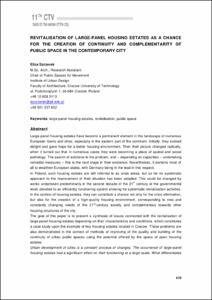Mostra el registre d'ítem simple
Revitalisation of large-panel housing estates as a chance for the creation of continuity and complementarity of public space in the contemporary city
| dc.contributor.author | Szczerek, Eliza |
| dc.date.accessioned | 2016-10-06T14:07:32Z |
| dc.date.available | 2016-10-06T14:07:32Z |
| dc.date.issued | 2016-07 |
| dc.identifier.citation | Szczerek, Eliza. Revitalisation of large-panel housing estates as a chance for the creation of continuity and complementarity of public space in the contemporary city. A: Virtual City and Territory. "Back to the Sense of the City: International Monograph Book". Barcelona: Centre de Política de Sòl i Valoracions, 2016, p. 670-680. |
| dc.identifier.isbn | 978-84-8157-660-3 |
| dc.identifier.uri | http://hdl.handle.net/2117/90568 |
| dc.description.abstract | Large-panel housing estates have become a permanent element in the landscape of numerous European towns and cities, especially in the eastern part of the continent. Initially, they evoked delight and gave hope for a better housing environment. Then their picture changed radically, when it turned out that in numerous cases they were becoming a place of spatial and social pathology. The search of solutions to the problem, and – depending on capacities – undertaking remedial measures – this is the next stage in their existence. Nevertheless, it pertains most of all to wealthier European states, with Germany being in the lead in this respect. In Poland, such housing estates are still referred to as crisis areas, but so far no systematic approach to the improvement of their situation has been adopted. This could be changed by works undertaken predominanly in the second decade of the 21st century at the governmental level, devoted to an efficiently functioning system allowing for systematic revitalisation activities. In the context of housing estates, they can constitute a chance not only for the crisis elimination, but also for the creation of a high-quality housing environment, corresponding to new and constantly changing needs of the 21st-century society and complementary towards other housing structures of the city. The goal of this paper is to present a synthesis of issues connected with the revitalisation of large-panel housing estates depending on their characteristics and conditions, which constitutes a case study upon the example of two housing estates located in Cracow. These problems are also demonstrated in the context of methods of improving of the quality and building of the continuity of urban public spaces using the potential offered by the space of open housing estates. |
| dc.format.extent | 11 p. |
| dc.language.iso | eng |
| dc.publisher | Centre de Política de Sòl i Valoracions |
| dc.relation.ispartof | International Conference Virtual City and Territory (11è: 2016: Cracòvia) |
| dc.rights | Attribution-NonCommercial-NoDerivs 3.0 Spain |
| dc.rights.uri | http://creativecommons.org/licenses/by-nc-nd/3.0/es/ |
| dc.subject | Àrees temàtiques de la UPC::Urbanisme |
| dc.subject | Àrees temàtiques de la UPC::Arquitectura::Tipologies d'edificis::Habitatges |
| dc.subject.lcsh | Public spaces -- Poland -- Kraków |
| dc.subject.lcsh | Condominiums -- Poland -- Kraków |
| dc.subject.other | Large-panel housing estates |
| dc.subject.other | Revitalisation |
| dc.subject.other | Public space |
| dc.title | Revitalisation of large-panel housing estates as a chance for the creation of continuity and complementarity of public space in the contemporary city |
| dc.type | Conference report |
| dc.subject.lemac | Espais públics -- Polònia -- Cracòvia |
| dc.subject.lemac | Condomini -- -- Polònia -- Cracòvia |
| dc.identifier.doi | 10.5821/ctv.8082 |
| dc.rights.access | Open Access |
| local.citation.contributor | Virtual City and Territory |
| local.citation.pubplace | Barcelona |
| local.citation.publicationName | Back to the Sense of the City: International Monograph Book |
| local.citation.startingPage | 670 |
| local.citation.endingPage | 680 |
Fitxers d'aquest items
Aquest ítem apareix a les col·leccions següents
-
11th Congress Virtual City and Territory, Krakow, 6-8 July 2016 [121]
Back to the sense of the city


